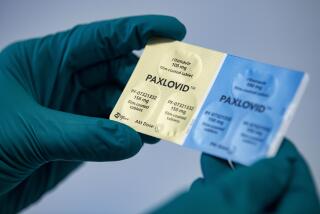Stop-and-start HIV treatment found risky
Taking HIV patients off their medications during periods when the disease appeared to be under control is a risky -- and sometimes fatal -- treatment strategy, according to a large international study published today.
Patients who cycled on and off their drugs were 2.6 times more likely to die or develop AIDS-related symptoms compared with patients on continuous therapy, the study found. They were also 1.8 times more likely to develop serious heart, kidney or liver diseases.
Interrupted treatment was once seen as a promising way to reduce the toxic side effects of AIDS medications and to stretch the supply of drugs. But some small studies over the last few years suggested it might do more harm than good.
The new report, published in the New England Journal of Medicine, appears to be the definitive word on this strategy.
âI think, for practical purposes, this is the end,â said Dr. Anthony S. Fauci, director of the National Institute of Allergy and Infectious Disease, which funded the $73-million study.
The human immunodeficiency virus attacks a class of immune cells called T cells. Antiretroviral drugs inhibit HIV replication.
The rationale for interrupted treatment has been undermined in the last five years as AIDS treatments have become much less toxic, said Dr. Eric S. Daar, chief of HIV medicine at Harbor-UCLA Medical Center in Torrance. Fears that patients would become resistant to AIDS antiviral drugs have also been alleviated by recent studies showing only a 5% rate of resistance, he said.
âThe issues that led to this study arenât as compelling as they were,â said Daar, who served for a time on the studyâs data and safety monitoring board. âSo why try to revisit an enormous study where we have a signal that there already may be problems?â
Stretching a limited drug supply is important for the developing world, but less critical in the U.S., he added.
The study -- dubbed Strategies for Management of Antiretroviral Therapy, or SMART -- involved 5,472 patients in 33 countries.
Researchers stopped dispensing antiretroviral medication to 2,720 of the patients in 2002. The drugs were reinstated when the patientsâ T-cell counts dropped below 250 per cubic millimeter, or when there were other signs that their HIV was threatening to develop into AIDS.
In the group with interrupted treatment, 120 people, or 4.4%, died or developed AIDS-related diseases in a four-year period, according to the study. Among the 2,752 patients in the continuous treatment group, 47, or 1.7%, died.
Researchers expected rates of cardiovascular disease to be 15% lower in the drug interruption group because heart problems are a common side effect of the drugs. But 48 people in that group -- compared with 31 on continuous treatment -- developed cardiovascular problems, the study found.
A safety monitoring board halted the study in January and recommended that patients on interrupted treatment go back to taking their medication full time. The study was expected to last about six years.
âWe got an answer to an important question in a very short time, and thatâs good,â said Dr. Donald Abrams, a professor of clinical medicine at UC San Francisco and coauthor of the study.
Researchers are continuing to monitor the patients, he said.
Fourteen of the studyâs 24 authors reported receiving money from drug companies.
*






